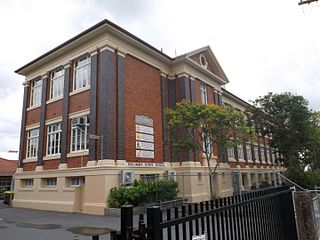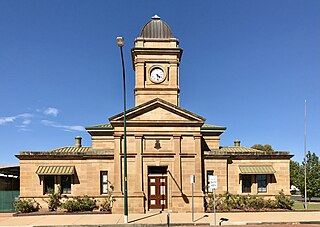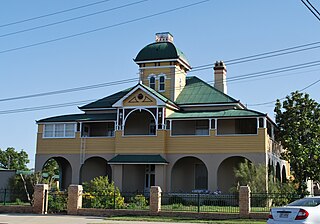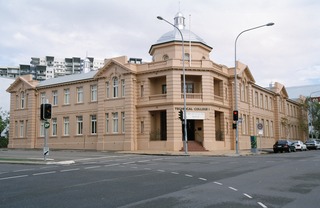
Toowoomba South State School is a heritage-listed former school at 158 James Street, South Toowoomba, Toowoomba, Toowoomba Region, Queensland, Australia. It was designed by Department of Public Works (Queensland). It was added to the Queensland Heritage Register on 2 December 2013.

Norman Park State School is a heritage-listed state school at 68–88 Agnew Street, Norman Park, City of Brisbane, Queensland, Australia. It was designed by Department of Public Works (Queensland) and built in 1900. It was added to the Queensland Heritage Register on 7 April 2017.

Sherwood State School is a heritage-listed state school at 464 Oxley Road, Sherwood, City of Brisbane, Queensland, Australia. The buildings were built from built from 1874 to 1974. The designers included Boulton & Paul, Ltd and the Department of Public Works (Queensland). It was formerly known as West Oxley National School. It was added to the Queensland Heritage Register on 15 July 2016.

Maryborough Courthouse is a heritage-listed courthouse at 170 Richmond Street, Maryborough, Fraser Coast Region, Queensland, Australia. It was designed by Francis Drummond Greville Stanley and built in 1877 by John Thomas Annear for the Queensland Government. It is also known as Maryborough Court House and Government Offices. It was added to the Queensland Heritage Register on 21 October 1992.

Oak Lodge and Spreydon is a heritage-listed pair of villas at 7 Warra Street & 30 Rome Street, Newtown, Toowoomba, Toowoomba Region, Queensland, Australia. They were designed by architectural firm James Marks and Son and was built from 1890s to c. 1923. They were added to the Queensland Heritage Register on 1 October 2003.
Gladstone House and Cottage is a heritage-listed detached house at 1B–3 Gladstone Street, Newtown, Toowoomba, Toowoomba Region, Queensland, Australia. It was designed by Harry Marks for himself and built c. 1908. It is also known as St Rest. It was added to the Queensland Heritage Register on 13 January 1995.

Bulimba State School is a heritage-listed private-school at 261 Oxford Street, Bulimba, Queensland, Australia. It was built from 1915 to 1955. It was added to the Queensland Heritage Register on 26 November 1999.

Brisbane South Girls and Infants School is a heritage-listed state school at 112 Merivale Street, South Brisbane, Queensland, Australia. It was built from 1864 to 1932. It is also known as Brisbane South Intermediate School, South Brisbane Primary School, and currently as Brisbane State High School Block H. It was added to the Queensland Heritage Register on 31 October 1994.

Fortitude Valley State School is a heritage-listed former state school at 95 Brookes Street, Fortitude Valley, City of Brisbane, Queensland, Australia. It was designed by Benjamin Backhouse and built from 1867 to 1913. It is also known as State Emergency Services State Headquarters and former Fortitude Valley Boys School and former Fortitude Valley Girls and Infants School. It was added to the Queensland Heritage Register on 26 March 1999.

Our Lady of Assumption Convent is a heritage-listed former Roman Catholic convent at 8 Locke Street, Warwick, Southern Downs Region, Queensland, Australia. It was designed by Simkin & Ibler and built from 1891 to 1914. It is also known as Assumption College, Cloisters, and Sophia College. It was added to the Queensland Heritage Register on 21 October 1992.

Warwick Court House and Police Complex is a heritage-listed courthouse at 88 Fitzroy Street, Warwick, Southern Downs Region, Queensland, Australia. It was designed by John James Clark and built from 1885 to 1914 by William G Conley. It was added to the Queensland Heritage Register on 21 October 1992.

St Mary's Presbytery is a heritage-listed Roman Catholic presbytery of St Mary's Roman Catholic Church at 142 Palmerin Street, Warwick, Southern Downs Region, Queensland, Australia. It was designed by Wallace & Gibson and built from 1885 to 1887 by John McCulloch. It is also known as Father JJ Horan's private residence. It was added to the Queensland Heritage Register on 31 July 2008.

Block A of the Rockhampton Technical College is a heritage-listed technical college building at Bolsover Street, Rockhampton City, Rockhampton, Rockhampton Region, Queensland, Australia. It was designed by Thomas Pye and built in 1914. It is also known as Rockhampton College of T.A.F.E. and Rockhampton State High School and Technical College. It was added to the Queensland Heritage Register on 21 October 1992.

Block A of Townsville Technical College is a heritage-listed technical college building at 212-260 Stanley Street, Townsville CBD, City of Townsville, Queensland, Australia. It was designed by Department of Public Works (Queensland) and built from 1920 to 1921. It is also known as Townsville State High School and the City Campus of the Barrier Reef Institute of TAFE. It was added to the Queensland Heritage Register on 13 May 2004.

Animal Research Institute Buildings is a heritage-listed set of research station buildings at 681 Fairfield Road, Yeerongpilly, City of Brisbane, Queensland, Australia. It is also known as Stock Experiment Station (1909-1932) and Animal Research Station (1932-1953). It was added to the Queensland Heritage Register on 13 June 2008.

Lake Clarendon State School is a heritage-listed state school at 35 Lake Clarendon Road, Lake Clarendon, Lockyer Valley Region, Queensland, Australia. It was built from 1901 to 1902 by Patrick Fagan. It was added to the Queensland Heritage Register on 12 June 2015.

Yeronga State School is a heritage-listed state school at 150 Park Road, Yeronga, City of Brisbane, Queensland, Australia. Its buildings were designed by Department of Public Works (Queensland), Thomas Robert Gladwin and Boulton & Paul Ltd and built from 1892 to 1960. It was added to the Queensland Heritage Register on 11 March 2016.

Virginia State School is a heritage-listed state school at 1690 Sandgate Road, Virginia, City of Brisbane, Queensland, Australia. It was designed by Queensland Department of Public Works and built from 1920 to 1933. It was added to the Queensland Heritage Register on 28 August 2015.

Bundaberg State High School is a heritage-listed state high school and technical college at 37 Maryborough Street, Bundaberg South, Bundaberg, Bundaberg Region, Queensland, Australia. It was built from 1920 to 1956. It was added to the Queensland Heritage Register on 22 June 2017.

Dutton Park State School is a heritage-listed government primary school at 112 Annerley Road, Dutton Park, City of Brisbane, Queensland, Australia. It was built from 1916 to 1934. It was also known as Woolloongabba State School, Woolloongabba Boys State School, and Dutton Park Boys State School. It was added to the Queensland Heritage Register on 30 November 2018.






















